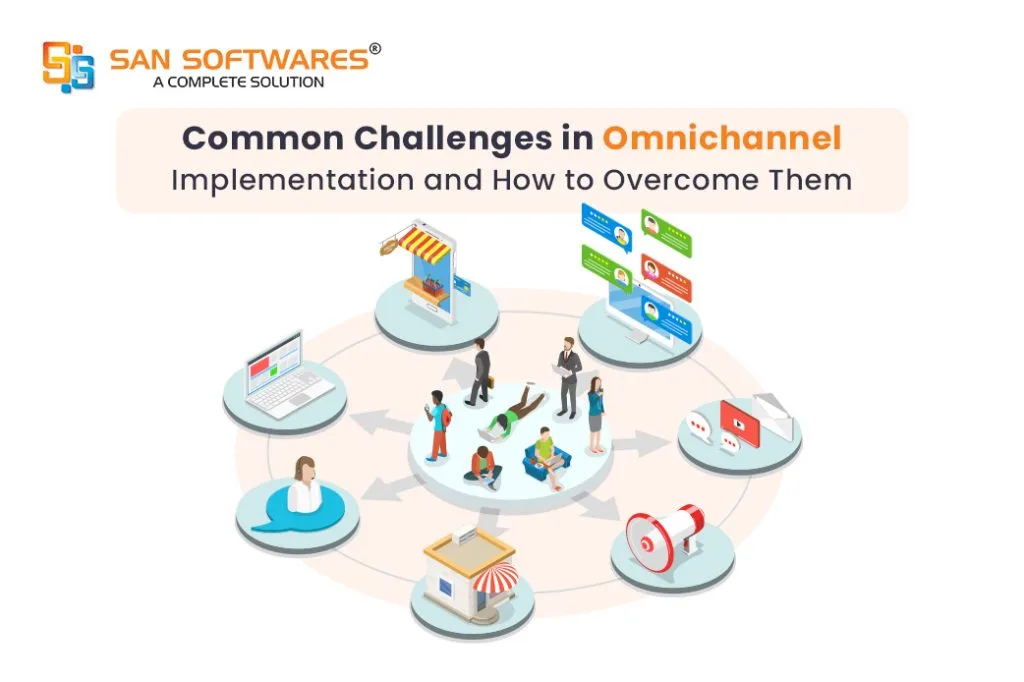
In the age of digital transformation, implementing omnichannel solutions is an important part for businesses striving to create a unified and seamless customer experience. Omnichannel innovations aim to connect various customer touch points- weather online or over phone- into a coherent system.
However, achieving an effective omnichannel strategy comes with a set of challenges. Let’s explore some of these common obstacles and provide actionable solutions for successful Omnichannel Integration.
Challenges: One of basic challenges in integrating omnichannel is fragmented customer data. Businesses often struggle with siloed data across multiple channels, such as e-commerce sites and call-centers. This scattered information makes it difficult for a comprehensive customer profile.
Solutions: Implementing a unified Customer Relationship Management (CRM) system centralized customer data from all channels. A robust CRM integrates seamlessly with other digital tools and platforms, providing a comprehensive 360-degree view of customer interactions. It ensures that agents across call centers and other touchpoints have access to consistent and updated information, amplifying personal service delivery.
Challenges: Integrating various technology platforms that effortlessly communicate with each other can present a significant challenge. The conventional methods employed within call centers may not be in harmony with the advancements in digital technology, leading to compatibility challenges that interrupt the seamless exchange of information.
Solutions: Consider investing in an omnichannel platform that is capable of supporting seamless integration with both new and existing technologies. It is advisable to select Application Programming Interfaces (APIs) that enable effortless data transfers across systems. Consistent software updates and the alignment of new tools with a comprehensive integration strategy can effectively mitigate disruptions in the communication flow.
Challenges: Maintaining consistency in customer experience across various channels is often difficult.Engagement with customers through social media platforms ought to be accorded the same standard of service as that provided through telephone interactions or in-person visits to a physical establishment.
Solutions: Develop comprehensive training programs for customer service representatives and establish uniform protocols for customer interactions. It is imperative that all team members are well-acquainted with the organization’s tone, core values, and exemplary practices in engaging with customers. Additionally, allocating resources towards omnichannel analytics tools can facilitate the monitoring of customer interactions and identify inconsistencies in service quality across various channels.
Challenges: Representatives in call centers and associated customer service personnel may find themselves inadequately trained to proficiently manage new omnichannel systems. This deficiency in knowledge can result in suboptimal resolution of customer issues and a deterioration in the quality of service provided.
Solutions: Establish ongoing training initiatives that concentrate on omnichannel integration, including the techniques required to seamlessly transition between various platforms and manage intricate customer inquiries across different channels. Activities such as role-playing exercises, workshops, and interactive e-learning courses can enhance best practices and foster confidence among employees.
Challenges: Managing logistics across various channels presents a significant challenge, particularly within the retail sector. It is imperative for companies to guarantee product availability across all channels, while simultaneously avoiding the duplication of efforts and the creation of stock conflicts.
Solutions: Institute real-time inventory management systems designed to offer comprehensive visibility into stock levels across various channels. Furthermore, embrace strategies like omni channel logistics, which facilitates order fulfillment from any location, tailored to the convenience of the customer.
Challenges: Clients anticipate experiences tailored to their preferences, yet numerous organizations fall short due to insufficient tools or infrastructure necessary to provide customized content or recommendations across various channels.
Solutions: Utilize artificial intelligence (AI) and predictive analytics to enhance the comprehension of customer behavior and customize their interactions in real-time. Omnichannel marketing platforms can facilitate the customization of campaigns based on users’ interests and purchasing patterns.
Challenges: The accumulation and administration of extensive customer data significantly increase the likelihood of security breaches and violations of privacy. It is imperative to guarantee the protection of this data while maintaining its accessibility for purposes of omnichannel utilization.
Solutions: Implement stringent cybersecurity protocols and adhere to pertinent data protection statutes, including the General Data Protection Regulation (GDPR) or the California Consumer Privacy Act (CCPA). Employ the utilization of data encryption, multi-factor authentication, and consistent audits to thwart unauthorized entry. Furthermore, the provision of comprehensive training to employees regarding optimal data management practices and security procedures is of paramount importance in safeguarding confidential data.
Empower Agents with Comprehensive Customer Context: It is imperative to equip call center agents with thorough access to customer information, enabling them to offer prompt and knowledgeable support. This involves integrating call center software with Customer Relationship Management (CRM) systems to ensure agents have a holistic view of a customer’s history across various channels.
Comprehensive Omnichannel Training: Agents should be trained to manage interactions across multiple channels, including phone calls, chat, email, and social media platforms. This training should cover a wide range of scenarios to ensure agents are well-prepared to address customer needs effectively.
Implementation of Quality Assurance Programs: The introduction of monitoring tools and periodic evaluations is crucial to gauge the quality of service rendered. Customer feedback should be leveraged to refine processes and maintain a standard of excellence.
Utilization of Sophisticated Call Routing Technologies: The adoption of intelligent call routing technologies is essential to direct customers to the most suitable agent based on the nature of the issue, the customer’s previous interactions, and the agent’s expertise.
Establishment of Feedback Loops: It is beneficial to foster a culture of feedback among agents regarding the omnichannel system. This approach facilitates continuous process improvement and the early identification of any issues. By adhering to these best practices, call centers can significantly enhance their customer service capabilities, leading to improved customer satisfaction and loyalty.
Successful Omnichannel Solutions require strategic planning, staff training, and technology integration. Challenges may arise, but a focused approach and right tools can mitigate them. Prioritizing customer experience and streamlining communication can lead to growth and loyalty.
SAN Softwares is a company dedicated to providing complete software solutions to Corporate and end-user customers.

SAN Softwares is a company dedicated to providing complete software solutions to Corporate and end-user customers.
